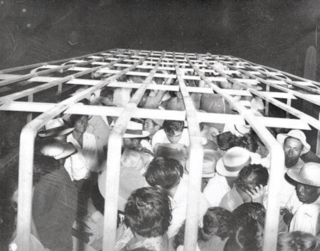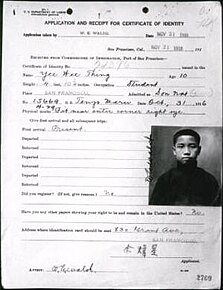Related Research Articles

Immigration to the United States is the international movement of non-United States nationals to reside permanently in the country. Immigration has been a major source of population growth and cultural change throughout much of the United States. history. All Americans, except for Native Americans, can trace their ancestry to immigrants from other nations around the world.

The Chinese Exclusion Act was a United States federal law signed by President Chester A. Arthur on May 6, 1882, prohibiting all immigration of Chinese laborers. Building on the earlier Page Act of 1875 which banned Chinese women from migrating to the United States, the Chinese Exclusion Act was the first, and remains the only, law to have been implemented to prevent all members of a specific ethnic or national group from immigrating to the United States.

The Immigration Act of 1924, or Johnson–Reed Act, including the Asian Exclusion Act and National Origins Act, was a United States federal law that prevented immigration from Asia and set quotas on the number of immigrants from the Eastern Hemisphere. Additionally, the formation of the U.S. Border Patrol was authorized by the act.

Operation Wetback was an immigration law enforcement initiative created by Joseph Swing, the Director of the United States Immigration and Naturalization Service (INS), in cooperation with the Mexican government. The program was implemented in June 1954 by U.S. Attorney General Herbert Brownell. The short-lived operation used military-style tactics to remove Mexican immigrants—some of them American citizens—from the United States. Though millions of Mexicans had legally entered the country through joint immigration programs in the first half of the 20th century, Operation Wetback was designed to send them back to Mexico.

The Geary Act was a United States law that extended the Chinese Exclusion Act of 1882 by adding onerous new requirements. It was written by California Representative Thomas J. Geary and was passed by Congress on May 5, 1892.
Immigration reduction refers to a social movement in the United States that advocates a reduction in the amount of immigration allowed into the country. Steps advocated for reducing the numbers of immigrants include advocating stronger action to prevent illegal entry and illegal immigration, and reductions in non-immigrant temporary work visas. Some advocate a tightening of the requirements for legal immigration requirements to reduce total numbers, or move the proportions of legal immigrants away from those on family reunification programs to skills-based criteria. What separates it from others who want immigration reform is that reductionists see immigration- or one of its forms- as being a significant source of social, economic, and environmental problems, and wish to cut current immigration levels.
Asian immigration to the United States refers to immigration to the United States from part of the continent of Asia, which includes East Asia, Southeast Asia, and South Asia. Historically, immigrants from other parts of Asia, such as West Asia were once considered "Asian", but are considered immigrants from the Middle East. Asian-origin populations have historically been in the territory that would eventually become the United States since the 16th century. The first major wave of Asian immigration occurred in the late 19th century, primarily in Hawaii and the West Coast. Asian Americans experienced exclusion, and limitations to immigration, by the United States law between 1875 and 1965, and were largely prohibited from naturalization until the 1940s. Since the elimination of Asian exclusion laws and the reform of the immigration system in the Immigration and Nationality Act of 1965, there has been a large increase in the number of immigrants to the United States from Asia.
Chain migration is a term used by scholars to refer to the social process by which migrants from a particular town follow others from that town to a particular destination. The destination may be in another country or in a new location within the same country.
Canadian immigration and refugee law concerns the area of law related to the admission of foreign nationals into Canada, their rights and responsibilities once admitted, and the conditions of their removal. The primary law on these matters is in the Immigration and Refugee Protection Act, whose goals include economic growth, family reunification, and compliance with humanitarian treaties.
Illegal immigration to the United States is the process of migrating into the United States in violation of federal immigration laws. This can include foreign nationals (aliens) who have entered the United States unlawfully, as well as those who lawfully entered but then remained after the expiration of their visas, parole, TPS, etc. Illegal immigration has been a matter of intense debate in the United States since the 1980s.

Illegal immigration refers to the migration of people into a country in violation of the immigration laws of that country, or the continued residence without the legal right to live in that country. Illegal immigration tends to be financially upward, from poorer to richer countries. Illegal residence in another country creates the risk of detention, deportation, and/or other sanctions.
In the early years of its existence, the United States had no formal immigration laws, but established clear naturalization laws. Anyone who wanted to vote or hold elective office had to be naturalized. Only those who went through the naturalization process and became a citizen could vote or hold elective office.

Angel Island Immigration Station was an immigration station in San Francisco Bay which operated from January 21, 1910 to November 5, 1940, where immigrants entering the United States were detained and interrogated. Angel Island is an island in San Francisco Bay. It is currently a State Park administered by California State Parks and a California Historical Landmark. The island was originally a fishing and hunting site for Coastal Miwok Indians, then it was a haven for Spanish explorer Juan Manuel de Ayala. Later, it was developed as a cattle ranch, then, starting with the Civil War, the island served as a U.S. Army post. During the island's Immigration Station period, the island held hundreds of thousands of immigrants, the majority from China, Japan, India, Mexico and the Philippines. The detention facility was considered ideal because of its isolated location, making it very easy to control immigrants, contain outbreaks of disease, and enforce the new immigration laws. The station is listed on the National Register of Historic Places under the title Angel Island, U.S. Immigration Station, and is a National Historic Landmark. The station is open to the public as a museum – "a place for reflection and discovery of our shared history as a nation of immigrants".
Under the public charge rule, immigrants to United States classified as Likely or Liable to become a Public Charge may be denied visas or permission to enter the country due to their disabilities or lack of economic resources. The term was introduced in the Immigration Act of 1882. The restriction has remained a major cause for denial of visas and lawful permanent residency ever since; in 1992, about half of those denied immigrant and non-immigrant visas for substantive reasons were denied due to the public charge rule. However, the administrative definition of "public charge" has been subject to major changes, notably in 1999 and 2019.

The Immigration Act of 1903, also called the Anarchist Exclusion Act, was a law of the United States regulating immigration. It codified previous immigration law, and added four inadmissible classes: anarchists, people with epilepsy, beggars, and importers of prostitutes. It had minimal impact and its provisions related to anarchists were expanded in the Immigration Act of 1918.

Emigration from Mexico is the movement of people from Mexico to other countries. The top destination by far is the United States, by a factor of over 150 to 1 compared to the second most popular destination, Canada.
United States v. Ju Toy, 198 U.S. 253 (1905), is a United States Supreme Court case in which the Supreme Court conceded its right to judicial review over immigration matters. The case held that "a citizen of Chinese parentage seeking admission to the United States" could be excluded by the administrative immigration authorities, even when being denied a hearing before a judicial body on the question whether they were indeed a citizen. The Court determined that refusing entry at a port does not deny due process and held that findings by immigration officials are conclusive and not subject to judicial review unless there is evidence of bias or negligence. This case marked a shift in the court in respect to habeas corpus petitions and altered the judicial landscape for citizens applying for admission into the United States as well as for those facing deportation.

Deportation and removal from the United States occurs when the U.S. government orders a person to leave the country. In fiscal year 2014, Immigration and Customs Enforcement conducted 315,943 removals. Criteria for deportations are set out in 8 U.S.C. § 1227.

Paper sons or paper daughters is a term used to refer to Chinese people who were born in China and illegally immigrated to the United States by purchasing documentation which stated that they were blood relatives to Chinese Americans who had already received U.S. citizenship. Typically it would be relation by being a son or a daughter. Many fled China because of constant war and poverty that occurred in China due to the corrupt Qing Dynasty. Several historical events such as the Chinese Exclusion Act and San Francisco earthquake of 1906 caused the illegal documents to be produced.

The Immigration Act of 1891, also known as the 1891 Immigration Act, was a modification of the Immigration Act of 1882, focusing on immigration rules and enforcement mechanisms for foreigners arriving from countries other than China. It was the second major federal legislation related to the mechanisms and authority of immigration enforcement, the first being the Immigration Act of 1882. The law was passed on March 3, 1891, at the end of the term of the 51st United States Congress, and signed into law by then United States President Benjamin Harrison.
References
- 1 2 3 4 5 6 7 8 Zeringue, Marshal (August 14, 2008). "Fae Myenne Ng". Author Interviews. Retrieved June 11, 2015.
- 1 2 3 4 5 6 Hing, Bill. "Amnesty—Past and Present". Angel Island Immigrant Station Foundation. Archived from the original on June 13, 2015. Retrieved June 11, 2015.
- ↑ Kwok, Steve. "My Father Was a Paper Son". Archived from the original on December 2, 2016. Retrieved June 11, 2015.
- ↑ "Chinese Confession Program". Museum of Chinese in America. Retrieved May 29, 2015.
- 1 2 Kane, Alice. "Chinese-American Genealogy" . Retrieved June 11, 2015.